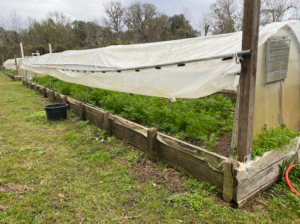Two of the most passionate types of gardeners are those who plant in the ground, vs those who plant in raised beds. Each type of growing has its own advantages and in this article, we will explore the benefits of each style of planting so as a reader you’re able to make the best choice for yourself.
Growing in the Ground
Growing plants in the ground has several advantages, both for the plants and for the gardener.
 One of the main advantages of growing plants in the ground is that it allows the plants to establish deep roots, which can lead to stronger, healthier plants. When plants are grown in containers or raised beds, their root systems are often confined, which can limit their growth. In the ground, however, plants can spread their roots out and access a larger volume of soil, leading to better access to nutrients and water.
One of the main advantages of growing plants in the ground is that it allows the plants to establish deep roots, which can lead to stronger, healthier plants. When plants are grown in containers or raised beds, their root systems are often confined, which can limit their growth. In the ground, however, plants can spread their roots out and access a larger volume of soil, leading to better access to nutrients and water.
Another advantage of growing plants in the ground is that it allows for more diverse plant communities. When plants are grown in containers or raised beds, it is often necessary to isolate them from other plants to prevent competition for resources (not applicable to all plant arrangements). In the ground, however, different plant species can coexist and even benefit each other through processes like nitrogen fixing or pest control. This can lead to a more diverse and productive garden.

Growing plants in the ground also allows for natural soil processes to occur, such as the development of a healthy soil ecosystem. When plants are grown in containers or raised beds, it is often necessary to add artificial fertilizers or soil amendments to maintain soil health. In the ground, however, natural processes like decomposition and nutrient cycling can occur, leading to healthier soil and plants. Growing plants in the ground can be more cost-effective. While raised beds and containers can be expensive to purchase and maintain, growing plants in the ground requires fewer inputs and can be more economical in the long run.
Overall, growing plants in the ground has many advantages, including the ability for plants to establish deep roots, the development of a diverse plant community, and the ability for natural soil processes to occur. While containers and raised beds can be useful in certain situations, growing plants in the ground can be a cost-effective and low-maintenance option for the home gardener.
Growing in Raised Beds
Growing plants in raised beds has several advantages, both for the plants and for the gardener.
 One of the main advantages of raised beds is that they allow for better drainage and soil quality. Because the soil in a raised bed is not compacted by foot traffic, it is easier for water and air to circulate, leading to healthier plants. Additionally, raised beds allow the gardener to control the quality of the soil, as it is easier to add nutrients and compost to a raised bed than to a traditional garden.
One of the main advantages of raised beds is that they allow for better drainage and soil quality. Because the soil in a raised bed is not compacted by foot traffic, it is easier for water and air to circulate, leading to healthier plants. Additionally, raised beds allow the gardener to control the quality of the soil, as it is easier to add nutrients and compost to a raised bed than to a traditional garden.
Raised beds also make it easier to practice crop rotation, as the beds can be easily divided and rearranged to prevent soil-borne diseases and pests from building up in a particular area. This can lead to healthier plants and a more diverse and productive garden.
Another advantage of raised beds is that they can be easier on the back and knees. Because the bed is elevated, it is easier for the gardener to reach the plants without having to bend over or kneel on the ground. This can be especially helpful for those with mobility issues or for those who want to avoid straining their back while gardening.
Raised beds can also be more aesthetically pleasing than traditional gardens, as they can be designed and shaped to fit the desired look and feel of a garden. They can be made from a variety of materials, such as wood, stone, or metal, and can be customized to fit the style of the home or garden.
Raised beds are also more efficient in terms of water use. Because the soil in a raised bed warms up more quickly in the spring, plants can be started earlier in the season. This can lead to a longer growing season and more productive plants. Additionally, because the soil in a raised bed is not compacted, it is easier for water to reach the plants’ roots, leading to more efficient water use.
 Raised beds can also be a great way to garden in small spaces or in areas with poor soil quality. Because the soil can be controlled and the bed is elevated, it is possible to grow a variety of plants in a small area, even if the native soil is not conducive to plant growth.
Raised beds can also be a great way to garden in small spaces or in areas with poor soil quality. Because the soil can be controlled and the bed is elevated, it is possible to grow a variety of plants in a small area, even if the native soil is not conducive to plant growth.
Overall, growing plants in raised beds has many advantages, including better drainage and soil quality, the ability to practice crop rotation and customize the bed’s appearance, and the ability to garden in small spaces or in areas with poor soil quality. Whether you are an experienced gardener or just starting out, raised beds can be a great addition to any garden.
Which style of gardening do you prefer? Head over to our gardening community and discuss. We have many groups and posted focused on discussing raised beds and traditional growing.

Contact Author
 info@gardensavvy.com
info@gardensavvy.com Recent Posts
- Smart Gardening: How Technology Is Revolutionizing Horticulture
- Understanding Gardening Zones: What You Need to Know
- The Right Tools For Your Gardening And Landscaping Needs
- Maximizing Your Harvest: Square Foot Gardening Chart for Beginners
- Holiday Garden Scents: Plants for Natural Aromatherapy in Your Home









